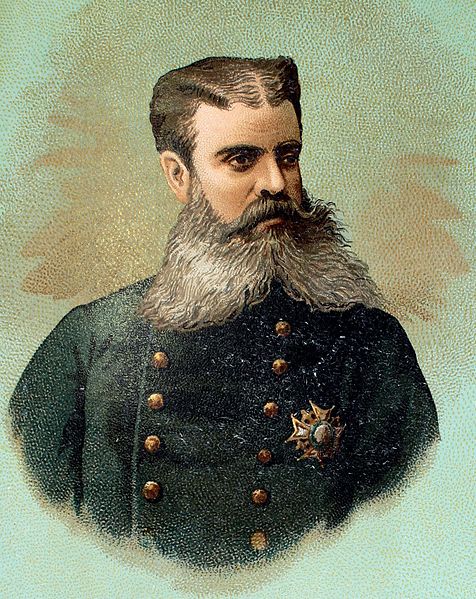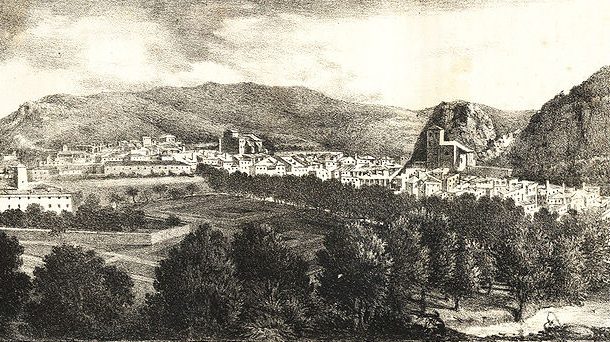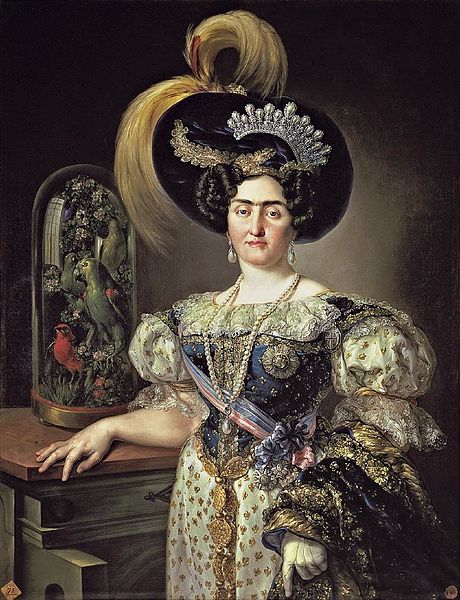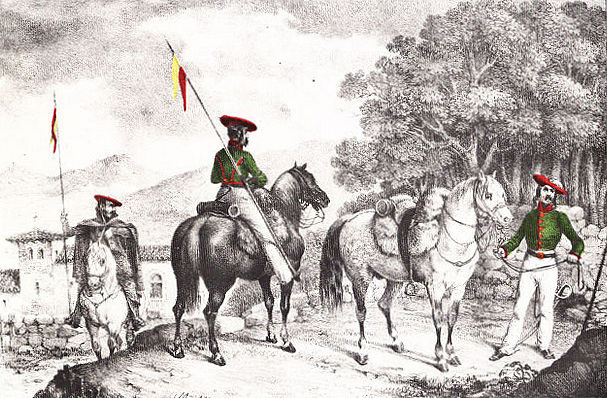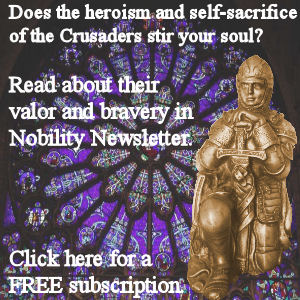
Portrait of Infante Carlos María Isidro de Borbón, Count of Molina, in the uniform of captain general.
On the evening of the same day a review was held of the troops engaged in the last battle. Colonel Auriol, in the kindest manner, gave me a first-rate mount, and I was thus able to join the staff and assist in this very interesting event.
Between five and six o’clock Don Carlos and Dona Margarita left their house in the Plaza, which is now honoured with the name of “the Palace.” Don Carlos, who was dressed in the uniform of a general, with the order of the Golden Fleece suspended to his neck, mounted a fine iron-gray charger; his wife, who is an accomplished horsewoman, rode a jet black Andulsian They were followed by the Countess Flores, who, like the Duchess, wore a plain black habit, and a scarlet boina, placed jauntily on the side of the head; Generals Dorregaray, Argonz, Larramendi, and Iturmendi, Duke de la Rocca, Brigadier Alvarez, Coude de Silva, Colonel Auriol, and a number of other officers. Through a multitude of cheering people and clouds of dust we rode through Irache and on to the lower slopes of Monte Jurra.
Here, in eight or nine long parallel lines, twenty-seven battalions of infantry were drawn up, with six batteries of mountain artillery on the left and a small body of cavalry in rear. General Mendiri, the newly created Count of Abarzuza, here received his King and Queen, and the brigadiers and colonels commanding regiments galloped off to take up their respective posts.
No better spot could have been selected for this review, although, being on the slope, of a mountain, where the ground is furrowed with small watercourses, half concealed by thick tufts of heather, it is not well adapted, according to English notions, for a march past. But this was no show parade of brilliant uniforms laced with gold and silver and shining helmets and waving feathers: 18,000 men, engaged in a sanguinary and, unfortunately, fratricidal war, were here drawn up, after one of the most important battles of the campaign, to be inspected by those whom they regard as their rightful King and Queen, whatever the rest of Europe may say to the contrary. With the exception of some of the Navarrese regiments, which were clothed in coarse grey cotton tunics and trousers, the latter with a scarlet stripe, few of the regiments could pretend to any uniform, and consequently, perhaps, they might have excited some derision in Hyde Park or at Longchamps, on the Prater or at Potsdam. But no one who had seen them on the preceding Saturday, tenaciously defending their positions, and making charge after charge with the bayonet upon the well-trained troops who more than doubled them in numbers, could feel anything but admiration for their courage and gallantry.
There were reasons, too, why no more appropriate place could have been selected for this review, notwithstanding that the authorities at the Horse Guards would be inexpressibly shocked if any one were rash enough to suggest a similar parade ground for a review-and one might be found in the Highlands of Scotland. Here, at the food of Monte Jurra, which not long before had been the scene of a great battle, the view embraced not only Estella and its surrounding rock peaks, but also the two extreme points of the recent battlefield – Villatuerta, where it commenced on the 25th of June, and Pena-Muro, where it finished on the 27th. As far as the eye could reach were ranges of mountains, contrasting, the soft rounded lines and hazy beauty in which Claude de Lorraine so delighted with the perpendicular cliffs and bare rugged rocks preferred by Salvator Rosa. In the foreground was the magnificent monastery of Irache, backed by fruitful gardens, standing on a terrace above the valley watered by the little river Arga, and which was then rich with yellow grain already beginning to fall before the sickle. Over its highest tower was floating the white flag crossed with red, the only object which on that seemed to recall the full harvest that death was reaping in the internecine struggle which was and still is devastating the northern provinces of beautiful Spain.
As Don Carlos and the Duchess rode down the lines, followed by the staff, each regiment in succession presented arms, and the bands played the Royal March. Each battalion, when it had been inspected, gave a ringing cheer of “Viva el Rey! Viva la Reina de Espana!” Occasionally Don Carlos stopped to speak to officers whose regiments had specially distinguished themselves.
But not the least interesting and picturesque feature of the review was the crowd of people who had gathered from Estella and all the countryside. There were no brilliant equipages, or Amazons with attendant cavaliers, all known to the world of fashion; but there were thousands of peasants—elderly men and women who were actors in the last Carlist war; men astride mules, with their wives and daughters seated behind them on the crupper; parish priests; labourers who had left the fields and came cantering up, two at a time, on the same horse or mule, and hundreds of pretty girls and children. There were few young men in the crowd; these were mostly in the ranks. As their King and Queen rode from line to line, and cantered round the flanks of the battalions, this loyal multitude moved too, and they never lost an opportunity to get as close to them as possible, whilst cheers rang through the air and were echoed back by the rocks of Monte Jurra, and fans and handkerchiefs were waved in the wildest manner. People had come from the villages round Pampeluna, and even from Elizondo and places sixty or seventy miles distant, simply to see their acknowledged sovereigns.
As a tribute of gallantry to the Dona Margarita, every man in her own Navarrese regiment wore in his boina a bunch of the flower whose name she bears. Another noticeable fact was that he boina was the only headdress worn. It is common to the whole army, from Don Carlos in his general’s uniform to the private soldier in his rough peasant’s clothes and sandals, with the badge of the Sacred Heart embroidered on his left breast.
It was nearly eight o’clock before the inspection was concluded. Don Carlos and his wife, followed by the staff, then place themselves in a convenient position near the right of the first line, and the whole army marched past. The modest force of artillery came first, then infantry in fours; and as soon as they had passed the saluting point they wheeled and took the direction of their respective quarters, which in most cases, meant the mountainside, under open canopy of heaven. Each company cheered as it passed, and as they moved down the hill they could be heard singing hymns to the Virgin.
Among the Carlists, by John Furley (London: Samuel Tinsley, 1876) P. 276-280
Short Stories on Honor, Chivalry, and the World of Nobility—no. 593
